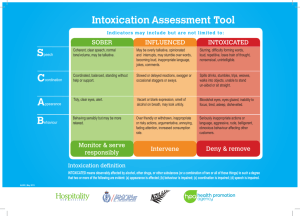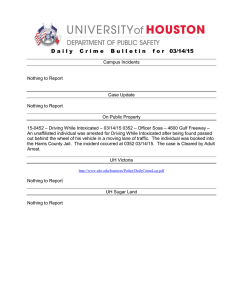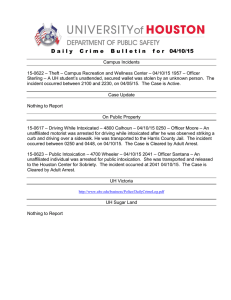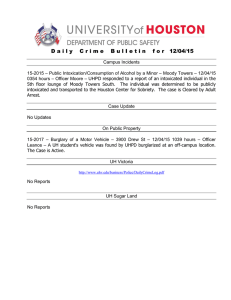robelyn & christiana report
advertisement
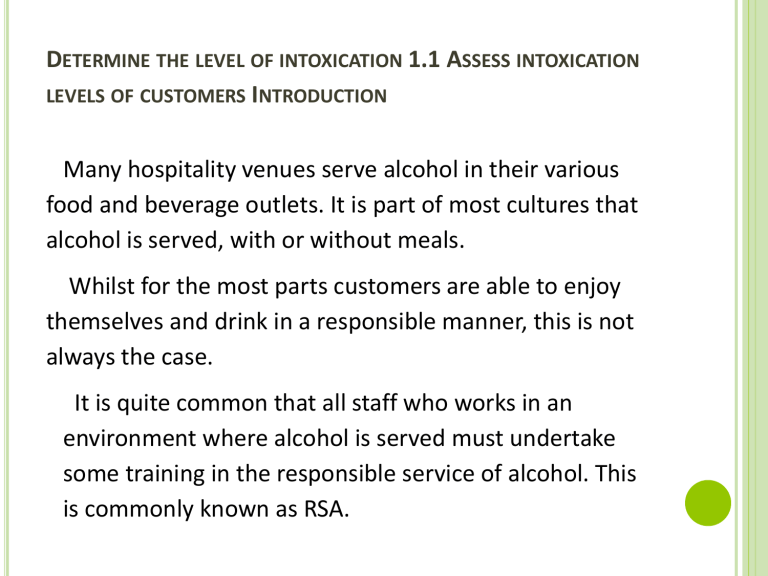
DETERMINE THE LEVEL OF INTOXICATION 1.1 ASSESS INTOXICATION LEVELS OF CUSTOMERS INTRODUCTION Many hospitality venues serve alcohol in their various food and beverage outlets. It is part of most cultures that alcohol is served, with or without meals. Whilst for the most parts customers are able to enjoy themselves and drink in a responsible manner, this is not always the case. It is quite common that all staff who works in an environment where alcohol is served must undertake some training in the responsible service of alcohol. This is commonly known as RSA. Duty of care Whilst the various legal obligations regarding the service of alcohol will be explained in later parts of the manual, the primary responsibility a business has is to ensure the health and safety of those who either frequent an establishment or are impacted due to its existence. Every business, regardless of what it sells owes a duty of care to its customers. It is not a new concept and is one that applies in every country. In this situation, managers and staff have a duty of care to make sure that all people are safe from harm when on the premises as well as when they leave. This duty of care is owed to all people in the environment including: Customers Owners Manager Staff General Public What is intoxication? Different countries will prohibit the sale or supply or alcohol to someone who appears to be intoxicated or drunk. By what does this mean? When do you know someone has reached this level? In summary, “intoxicated” is the body's response to having alcohol in the human system. This is always hard to identify so what signs exist that may indicate intoxication? Signs of intoxication The following signs can give you an idea of whether or not a person is intoxicated. Signs of intoxication include: What is intoxication? Different countries will prohibit the sale or supply or alcohol to someone who appears to be intoxicated or drunk. By what does this mean? When do you know someone has reached this level? In summary, “intoxicated” is the body's response to having alcohol in the human system. This is always hard to identify so what signs exist that may indicate intoxication? Signs of intoxication The following signs can give you an idea of whether or not a person is intoxicated. Signs of intoxication include Being clumsy Eyes seem unfocused or glassy Bumping into furniture and other people Staggering Falling down or tripping over things Inability to walk in a straight line Inability to do basic tasks like lifting a glass Knocking things over. Change in speech Having trouble talking in a normal manner Speech becomes slower and slurred Volume of speech becomes louder Person becomes outspoken Moods behavior and conduct Big changes in mood over time. Personality changes Becoming isolated from group Inappropriately affectionate Extremely outgoing Wanting to cause arguments Being over affectionate to strangers. Tool to help identify intoxication Whilst the previously mentioned signs of intoxication will help a staff member identify an intoxicated person, a tool can help staff members identify is a person is intoxicated is: C-Coordination A-Alcohol Smell U-Unsteady S- Slurred Speech E- Eyes Glazed Once you have identified that a customer is intoxicated, it is your responsibility to act in a prompt and appropriate manner. 1.2 Offer assistance to intoxicated customers politely Introduction When it is determined that a person is intoxicated, it is wise for staff to provide assistance where applicable, in line with company policies and relevant legislation. It is important to remember that each situation must be handled in a professional and discrete manner. No person likes to be told they are intoxicated or being given instructions on how to enjoy their experience, so where possible the dignity of the intoxicated person must be upheld. Monitor the environment Staff members must always be aware of the environment and alert to the consumption of alcohol by groups or individual customers within the establishment. Being able to deal with any potential problems as early as possible, will hopefully avoid situations that may put staff and customers at risk or reduce the enjoyment of the venue by others. When monitoring, be aware of: Types of drinks being ordered Who is ordering the drinks Who is consuming the drinks Rate of consumption Whether food is also being consumed People showing signs of intoxication Any drinking games being conducted Which people in the group could be of assistance when dealing with intoxicated patrons Types of assistance Depending on the level of intoxication of the customer there are a number of ways assistance can be offered, either directly or indirectly advised to the customer, to enable the customer to stay on the premises. These include: Talk to the customer or their friend – this helps determine not only the level of intoxication, but how they will respond to suggestions that may be suitable Briefly explain your responsibilities – you may wish to outline the house policy that applies, directly to the customer or a friend of theirs. Try to get the person on your side by explaining that whilst you would like the customer to stay on the premises, they must abide by the rules of the establishment Promoting non-alcoholic drinks – most venues will have a range of soft drinks, juices or cocktails which can be a suitable alternative to alcohol. Offering low-alcoholic beverages – some beverages such as beer come in a low alcoholic format which can be promoted. Alternatively half measures may be suggested when serving spirits Offer water – water is free of charge in most facilities. You may suggest a customer having a glass of water between alcoholic drinks or for a specific period of time Offer food – whether through providing a menu or offering complimentary or low costs snacks such as nuts and chips Slowing down service – try to delay the service of drinks to a person, however this should not be obvious as it may frustrate the customer Advise other staff – as to the amount of drinks the person has had or any concerns which you may have. 1.3 Refer difficult situations to an appropriate person within or outside of the establishment Introduction As customers become more intoxicated, the more difficult it may be to handle the situation yourself. In many cases customers will understand the rules that apply and will abide by them in order to enjoy their time on the premises. Appropriate internal person It must be remembered, that the health and safety of staff, other customers and the intoxicated person themselves is the primary objective when handling instances involving intoxication. There are a number of appropriate people who can be called upon to provide assistance or to handle difficult situations involving alcohol. These persons include: Supervisor or Manager – they will make or authorize courses of action to take Security – they will have the expertise to deal with the manner DJ – they have the capacity to communicate not only with different authorities but can also communicate directly to the patrons within the venue. Remember, if you feel you cannot handle a situation yourself, be smart and seek suitable support to handle any situation where you feel you are in harm. Suitable external persons to notify will be discussed in the next section. Reaching appropriate internal persons there must be an easy to use communication system to be able to notify appropriate internal people. Systems can include: Pagers Signals – verbal or hand Button Phone call. 1.4 Seek assistance from appropriate people for situations which pose a threat to safety or security of colleagues, customers or property Introduction As stated in the last section, if a situation appears to be out of control it is important that the correct person or authority is called. Whilst using internal sources of assistance are the first course of action, at times the situation may have gotten out of control and more serious action needs to be taken. Every organization should have a designated set of instructions and procedures to follow in the event of a variety of situations ranging from arguments, spiking of drinks, violence or medical harm, to name a few. Staff must be aware of which type of assistance to contact whenever these situations arise. Anytime a situation poses a risk it must be dealt with in a prompt manner abiding by all the laws required by the country. Reaching suitable external assistance As stated in the last section, if a situation appears to be out of control it is important that the correct person or authority is called in a prompt manner. Not only should managers state situations when each appropriate source of assistance should be notified, but also how to contact them. Easy to reach contact details can include: Special button Posters with contact numbers Speed dials other methods that are suitable. Explain the position to the customer using appropriate communication skills Introduction When handling intoxicated persons, there are a number of approaches that can be taken, depending on the individual situation and severity of the problem. Regardless of the action taken, it is important for staff to be professional and respectful in their approach. Handing intoxicated people should be done in a sensitive and discreet manner which solves the situation, not escalates it further. Steps when handling intoxicated customers The following T-A-K-E C-A-R-E steps can help resolve matters involving intoxicated patrons. Tell early Avoid put-downs Keep calm Ever courteous Clarify refusal Alternatives Report Echo Tell early- if staffs are aware of early signs of intoxication, they are able to help provide assistance to customers which enable them to still enjoy their experience. Some of these types of assistance were identified in Section 1.1. Avoid put-downs you must be respectful in your approach with people. Do not judge them or talk down to them. Keep calm- whilst it is not uncommon for intoxicated persons to talk in a rude manner to you, remember you are just doing your job and try not to take the comments personally. Try to use a calm and controlled voice. You don’t want to use loud or threatening words or tones which can further escalate the problem. Ever courteous- Regardless of the way that you may be treated by a specific customer, you must respect the customer and be professional and polite. Don’t be confrontational and demeaning about the person. Your role is to explain why you are taking a certain approach. Normally this involves identifying how a person may be breaking the law. Clarify refusal- You need to explain why a person may be refused a beverage, entry into the premises or the right to remain on the premises. Be practical in your explanation and stick to the facts. Don't get emotional or personal about the intoxicated patron. You may merely state that at this time, the law requires them to follow a certain action. You may want to remind the person they are welcome back when they abide by the law. Alternatives- If handled in a prompt manner, a staff member will be able to provide and explain a range of alternatives including switching to soft drinks or eating a meal, which will allow the customer to remain on the premises. At least you have placed some responsibility back in the customer's hands in relations to their actions. Report- Ensure other people are aware of what is happening. For legal reasons you may be required to keep a written record of events as they happen and the approach taken. Echo- You may wish to notify a friend of the intoxicated person why certain actions are taking place. They may be in a more controlled state and understand the situation more clearly. They can also become an ally when dealing with the intoxicated person. If the customer is a regular, you may wish to explain your actions and the reasons behind it when they next return and in a clearer frame of mind to avoid a re-occurrence. Assist the customer to leave the premises if necessary Introduction There may be times when all previous approaches to allow a customer to remain on the premises have failed and for the best interests and safety of everyone, the intoxicated person may be asked to leave the premises. Even at this time, staff must remain professional and respectful. This is important, given that it is very likely that the intoxicated person may not be acting in a reasonable manner or may become violent. When someone is required to leave It is often a legal requirement that an intoxicated person is not permitted to remain on the premises. Whilst is it unreasonable to ask every patron who is showing even the smallest sign of intoxication to leave, it is essential that a person will be asked to leave who: Is using or threatening violence Is disturbing the enjoyment of other patrons Is disorderly or not abiding by premises rules Is breaking the law Is using disgusting, profane or foul language Deal with intoxicated persons appropriately Introduction This manual has identified a variety of ways in which to deal with intoxicated persons, depending on the situation, level of intoxication and risks to others. Most of these strategies are not only helpful in professionally dealing with intoxicated patrons, but are also legal. This ensures that in the event, an investigation takes place in regards to a particular incident, management and staff can be confident they have followed the correct procedures and help mitigate any legal issue that may arise. Tips to remember Whilst a range of legally abiding steps is identified elsewhere in this manual, some important tips to remember include: Identify situations where problems may arise as early as possible Try to involve the customer by providing options Treat the customer professionally Don’t touch the customer, where possible Take action as early as possible Follow all house policies, rules and regulations
